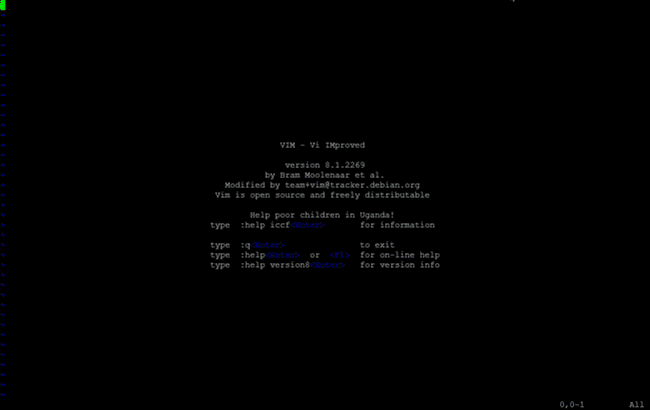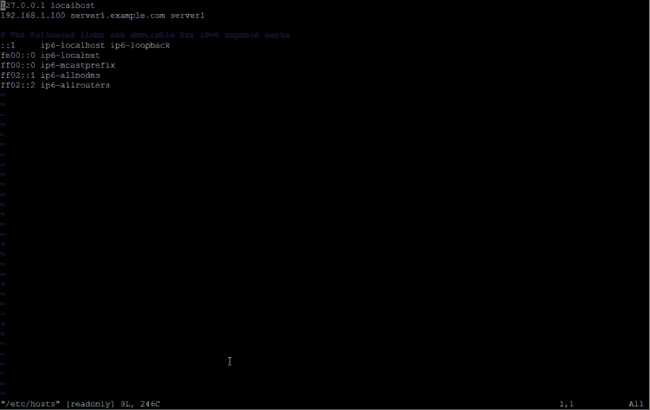Vim
Introduction
Vim is a command-line text editor, created by Bram Moolenar. It stands for Vi-IMproved; Vi was an older ubiquitous editor, which was enhanced to create Vim.
Why Vim?
Vim is all about efficiency. And there’s a couple of angles from which it approaches efficiency.
Core to Vim’s belief is that most people spend more time editing existing text than writing new text. This is especially true for software engineers who are often tasked with enhancing and maintaining existing code.
Vim allows you to be efficient by forcing you to only use the keyboard and then giving you the ability to use existing keyboard shortcuts as well as customize and create new ones for completing repetitive tasks quickly.
Whether you’re using a Mac, Windows, or some Linux distribution, Vim’s got you covered. In particular, if your day to day work involves working in the ssh’ed terminal sessions, Vim is your best friend. A popular alternative is emacs.
On the cluster, use VIM to edit the files on the edge node we provide. You do not need to become a VIM power user but as an IT engineer or someone who wants to be comfortable with IT tooling and concepts, knowing the basics of VIM will bring you a lot of comfort. For example, when you wish to change a configuration file or edit a script, it is much faster to open the file in VIM locally than download, edit and upload the same file over SFTP.
Which Vim?
There are two kinds of Vim available — one that runs in your terminal emulator, and another that runs as an independent graphical application. The terminal one comes by default on most operating systems. However, it might not be the latest one.
-
On Linux systems, you can install
vim-enhancedto get the recent terminal-vim using your favorite package manager. The package to install the graphical-vim (gvim) isvim-gnome(Debian/Ubuntu) andvim-X11(Fedora). -
neovimis a project that seeks to aggressively refactorvimsource code in order to achieve the following goals: Simplify maintenance to improve the speed that bug fixes and features get merged. -
On macOS, you can install
vimusing HomeBrew to get the recent terminal-vim. The package to install the graphical-vim (MacVim) ismacvim.
Installation
Vim is available for many different systems and there are several versions.
From source
The best way to install Vim on Unix is to use the sources. This requires a compiler and its support files. Compiling Vim isn’t difficult at all. You can simply type “make install” when you are happy with the default features.
git clone https://github.com/vim/vim.git
cd vim/src
makeWindows
For modern MS-Windows systems you can simply use the executable installer:
First steps
To open Vim, just type vim at the command-prompt.
To open a file in the beginning, type vim /etc/hosts at the command-prompt.
The Vim process is now running in the terminal. You should see a text file that associates IP addresses with hostnames.
Press i. You are now in Insert mode. You should see --INSERT-- prompted somewhere on your screen. In this mode, you can write, edit and delete text as if you were using any other text editor.
Press Esc. You are now back in Normal mode. In this mode, you can use all of the commands described thereunder. This is the main mode to edit text.
You might ask yourself: why do I need Normal mode if I can edit text in Insert mode? The idea behind Normal mode is that text editing is done much faster and more efficiently. For instance, to delete a line, press dd. In Insert mode, you whould have to select the entire line and delete it. As mentioned before, Vim is all about efficiency.
If you are done, press :wq to save the file and quit Vim.
Different modes
Vim is a modal text-editor. It has different modes to perform different tasks. The major ones are:
- Normal (N) — edit text
- Insert (I) — type text
- Command-line (C) — execute commands
Moving around
In contrast to regular text editor, you use keys h, j, k, and l which will respectively move the cursor left, down, up and right.
It is also possible to use the arrow keys.
Basic commands
Once typing is over, we can save the text by typing w in Command-line mode and pressing Enter (CR or carriage-return):
:wTo quit vim, type either q in command-line mode:
:qIf you try to quit vim when some contents in the open file are unsaved, vim will throw an error. In such a case, either write :q! to quit without saving the changes, or first save (using :w) then quit.
Advanced commands
Here are some of the editing commands:
a: around, append;A: append at the end of lineb: beginning of wordc: change (delete and switch to insert mode);C: change till the end of lined: delete;D: delete till the end of linee: end of current wordf: find in current lineh: alias to left arrowi: inside, switch to insert mode;I: insert at the beginning of linej: alias to down arrowk: alias to up arrowl: alias to right arrown: next search item;N:nin reverse ordero: open a new line below current line;O: open a new line above current linep: paste after the cursor position;P: paste before the cursor positionr: replace current character;R: switch to replace modet: tillu: undo (<C-r>is for redo)v: visual mode;V: visual-line mode;<C-v>: visual-block modew: next wordx: cuty: yank (copy)
Some of the commands have a two-letter combination:
dddeletes the current lineccchanges the current lineyycopies the current line
Visual-mode
Vim offers a visual mode to visually select regions of text, before applying a normal-mode command. For example,
vwfollowed byyselects till next word and copies selection.vt"followed bydselects till next ” and deletes the selection.
There is also a convenience visual-line mode that lets you select line-by-line. For example,
V(capitalV) followed byyselects the current line and copies it.Vfollowed by2jfollowed bydselects the current and the next two lines, and deletes them.
Further, there is a visual-block mode (triggered using <C-v>) that lets select text vertically. This is very helpful for deleting say a column in a table. Just select the column visually and press d.
Search
Vim provides an easy way to search content in the current buffer. Type the following in normal mode:
/searchterm " search forwards
?searchterm " search backwards
* " search current word forwards
# " search current word backwardsAfter searching something, jump to the next and previous occurrences of the search-term using n and N, respectively.
Search and replace
Vim also provides a sophisticated mechanism to replace occurrences of a word in the current buffer:
:%s/oldword/newword/c " replace one-by-one
:%s/oldword/newword/g " replace all occurrences at once

